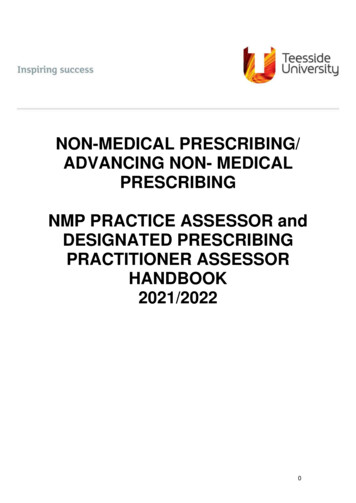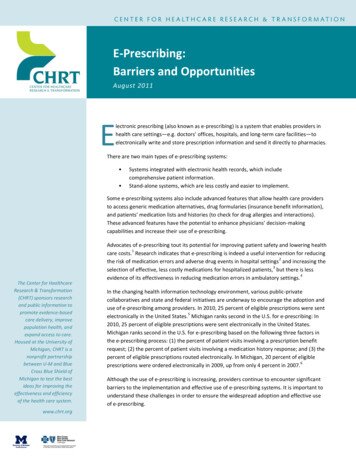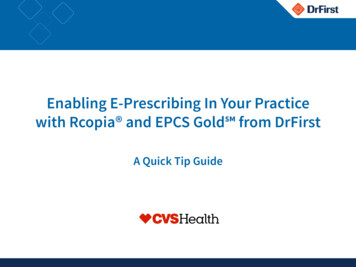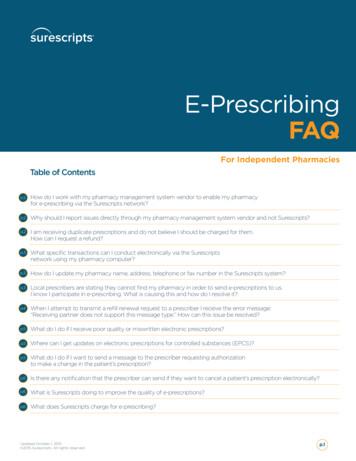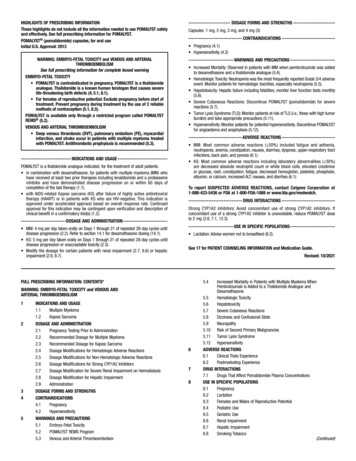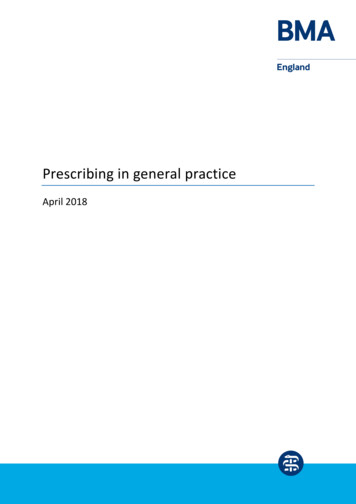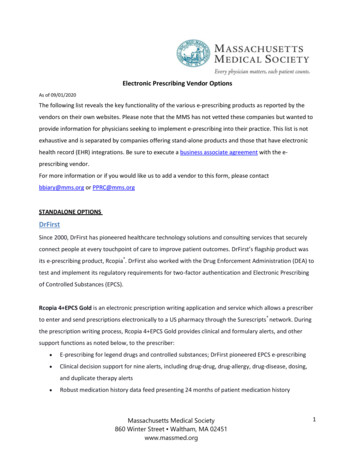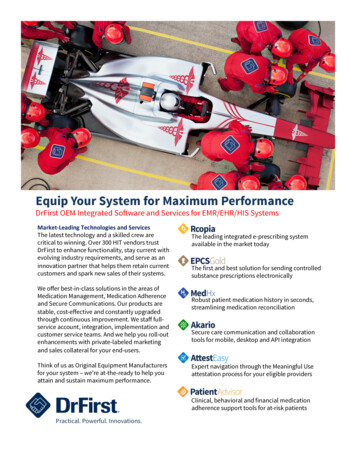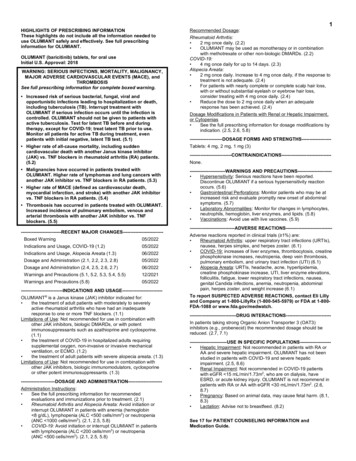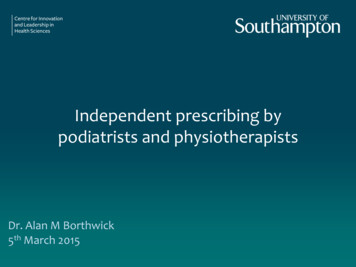
Transcription
Independent prescribing bypodiatrists and physiotherapistsDr. Alan M Borthwick5th March 2015
‘Prescribing’ in context “legally and otherwise, the physician’s right to diagnose, cut and prescribe isthe centre around which the work of many other occupations swings, andthe physician’s authority and responsibility in that constellation of work areprimary”(Freidson 1970) “prescribing is one of the core activities that demarcate the medicalprofession from other groups in British general practice, prescribing is thebattleground on which the cause of clinical autonomy is defended”(Britten 2001)
Prescribing in context:workforce redesign and the policy agendao neo-liberalism & economic rationalism (Boyce 2006; Smith & Baird 2007;Titcomband Lawrenson 2006; Weller 2006; Willis 2006)o“new ways of working”, “breaking down traditional barriers” & “workingacross traditional professional boundaries” (Allsop 2006; DoH 2000a, 2000b,2001)o “doctors will need to be prepared to let go of some of the work that others cansafely do” (Roxon 2008)
The Medicines Act (1968)‘The White paper [1967] reviews the action taken by the government in1962 as a result of the disquiet caused by the teratogenic actions ofthalidomide Lord Cohen recommended that legislation on the safety andefficacy of drugs was urgently required’(Cmnd. 3395, cited in BMJ, 16th September 1967, p.743).
The Medicines Act (1968) general sales list pharmacy only (P) prescription only medicines (POM) controlled drugs (schedule 1-3) (Home Office licence)POMs for 4 ‘approved prescriber’ groups only: doctors of medicine, dentists,veterinary surgeons and veterinary practitioners
Current mechanisms for AHPso Patient Specific Directionso Statutory exemptions (profession specific exemption lists)o Patient Group Directions (PGDs)o Supplementary Prescribing (CMP) (radiography)o Independent Prescribing (physiotherapy, podiatry, optometry,pharmacy, nursing)
Current mechanisms for AHPso Patient Specific Direction:o A written instruction from an independent prescriber for amedicine to be supplied and/or administered to a named patient
Statutory exemptions: ‘exemption list’o profession specific list of medicines (POM and P) for sale, supply oradministrationo associated with HCPC annotations (“local anaesthesia” and “prescription onlymedicines”)o podiatry, optometry and paramedics (& nurses)o does not constitute prescribing of medicines, only sale, supply and administration
The podiatrists’ list : Sale and SupplySale andsupply POMsamorolfineHCL morolfineHCL lacquer5%erythromycinco-dydramol10/500tioconazole sone1%
The podiatrists’ list: naline injection BPbupivacaine HCLmepivacaine HCLbupivacaine HCL with adrenalinemepivacaine HCL with adrenalineropivacaine HCLlevobupivacaine HCLlidocaine HCLlidocaine HCL with adrenalineprilocaine HCL
Recent changes: ‘exemption list’ addition: SI: 2011 No. 1327o Removal of limitations on pack sizes in relation to sale and supply of Co-Dydramoland Ibuprofen (3 day course to be part of professional SCP guidance)o Codeine Phosphate and Co-codamol added (3 day course to be part of SCPprofessional guidance)o Removal of restriction on administration of combinations of products on theexemptions listso Signed order provision
Unlicensed medicines: Liquefied phenol, pyrogallol, salicylic acid andmonochloroacetic acido MHRA (2009): where a substance does not have a primary mode ofaction which is pharmacological, metabolic or immunicological it fallsoutside the definition of a medicinal producto MHRA approval for ‘EZ Swab’ as a class 11b Medical Device (not a‘medicine’)12
Patient Group Directions (PGD) (DoH 2000a, 2000b, 2000c) Allows specified practitioners tosupply and/or administer namedmedicines directly to patients that fitthe criteria laid out in the PGD Doctor, pharmacists (andmicrobiologist in the case ofantibiotics) determine the medicinesto be listed
Patient Group Directions (PGD) (DoH 2000a, 2000b, 2000c) 9th August 2000: Amendment Orders applicable to NHS available to :o optometrists; pharmacists;o podiatrists; radiographers; orthoptists; physiotherapists; ambulanceparamedics; dietitians; occupational therapists;o speech and language therapists; prosthetists and orthotists; dentalhygienists and dental therapistso 2013: legislative change to enable authorisation by CCGs, local authorities andNHS England from April 2013 (SI 2013, No. 235, p 73-74)
Supplementary Prescribing A voluntary partnership between an IP, to implement a patient specific clinicalmanagement plan, with the patient’s agreement. The SP may prescribe medicines to individual, named patients whose medicines areoutlined in the CMP HCPC annotation “supplementary prescribing”
Supplementary Prescribing 253 physiotherapists (SP) 179 podiatrists (SP) 36 radiographers (SP)(Health and Care Professions Council figures March 2013)
Supplementary Prescribing 294 physiotherapists (SP) 195 podiatrists (SP) 41 radiographers (SP)(Health and Care Professions Council figures February 2014)
Supplementary Prescribing:challenges for AHPso practitioners in private sector (SP often not applicable)o community based, independent working with “no direct patientreferral from physicians”o ‘rate limited’ with limited uptakeo most remuneration for optometrists through sales of optical devices –not provision of professional serviceso reluctance of physicians to engage
‘mixing’ medicines: the lawo PGDs do not allow use of unlicensed medicineso ‘mixing’ corticosteroid with lignocaine (2 licensed medicines that are active ie not inert, in which one is a vehicle for delivery of the other) constitutes“manufacture” of a new medicine (for which there is no marketingauthorisation)o podiatrists and physiotherapists may now mix medicines as independentprescribers (2013) or as supplementary prescribers (if in CMP)
Human Medicines Regulations 2012o Human Medicines Regulations SI 2012, no. 1916o Draws together all Statutory Instruments into one piece oflegislationo Repeals much of the Medicines Act (1968)20
Physiotherapy and podiatrist independent prescribingo Ministerial approval 24th July 2012o Legislative Change : Human Medicines (Amendment) Regulations 2013, SI 2013 No.1855, 20th August 2013o Publication of OCF documentso Publication of HCPC standards (20th August 2013)o Single competency framework (May 2012, review May 2014)o HCPC validation of university SP/IP programmes: January 2014 onwardo independent podiatrist and physiotherapy prescribers qualify 2014o current SP via conversion programme qualify 2014
Independent Prescribingo Access to the full British National Formulary excepting:o Controlled drugs (specified list separately)o Unlicensed medicineso Mixing of medicineso “off label” prescribing (for use outside the terms of the productlicence)
Independent Prescribing by physiotherapists:scope of practice statementThe physiotherapy independent prescriber may prescribe anylicensed medicine within national and local guidelines for anycondition within their area of expertise and competence withinthe overarching framework of human movement, performanceand function23
The COLLEGEof PODIATRYIndependent Prescribing by podiatrists:scope of practice statementit is necessary to direct those members who are engaged in thepractice of prescribing of medicines to ensure that they concernthemselves only with those medicines which are relevant to thetreatment of disorders affecting the foot and associated structures, inline with current practice and consistent with published professionalguidance.Should a prescriber prescribe in a capacity other than that of apodiatrist they will have no redress to the Society for support shouldthat practice be brought into question or a claim be brought againstthem.24
controlled drugsPodiatry:ooooTemazepam (oral)Lorazepam (oral)Diazepam (oral)DihydrocodeinePhysiotherapy:o Dihydrocodeine (CD injected only)o Morphine salts – Oramorpho Fentanyl patcheso Oxycodone HClo Temazepamo Lorazepamo Diazepam25
The Devolved Administrationso Medicines legislation (Human Medicines Regulations SI 2012 no. 1916)applies to the whole UK:o England Ministers sign on behalf of England, Scotland and Waleso Northern Ireland Minister countersigns the amendmentso NHS Regulations are country specific (DA policy leads amend their ownregulations to allow prescribing in their own countries)o Controlled Drugs Regulations (legislation) amended by Home Officepolicy lead but:o legislation applies to England, Scotland & Waleso Northern Ireland requires separate legislation (via NI policy lead)26
What next?o NHS England : AHP Medicines Project established: 2013-2015o Independent prescribing for paramedicso IP for radiographerso SP / exemptions for dieteticso SP/ exemptions for orthoptists27
Outline curriculum framework: course requirements:o Key entry requirements full programme (paraphrased):o HCPC registeredo be practising where there is an identified needo demonstrate support of employer/sponsor (including confirmedsupervision in practice by DMP)o demonstrate medicines governance arrangements in placeo DMP recognised by commissioning organisation with experienceas supervisor/experience of field/ agreement to superviseo normally at least 3 years experience in prescribing areao be working at advanced practitioner level or equivalent28
Outline curriculum framework: course requirements:o Key entry requirements conversion programme (paraphrased):o HCPC registered as SPo practising as SP for the past 6 months prior to startingprogrammeo DMP statement stating competence to progress to IPo employer support, identified need etc (as full programme)29
Outline curriculum framework: course requirements:o Full programme: length (duration) :o 38 days in totalo 26 days theoretical learningo minimum of 90 hours practice based learning (12 days at 7.5hours)o delivered over a maximum period of 1 yearo normally completed within a 3-6 month period30
Outline curriculum framework: course requirements:o conversion programme: length (duration) :o not less than the equivalent of 2 days for the taught programme(of which at least 1 day should be face to face learning activities)o at least two 7.5 hour days learning in practice under thesupervision of a DMP31
Outline curriculum framework: course requirements:o Full programme assessment diet: compulsory elementso written examination (pass mark 80%)o numerical assessment (pass mark 100%)o portfolio of practice evidenceo submission of a personal formularyo practical demonstration of patient assessment andcommunication skillso testing of student understanding of professional,ethical and legal responsibilitieso completion of period of supervised practice with DMPsign-off32
Outline curriculum framework: course requirements:o Conversion programme assessment diet: compulsoryelementso satisfactory completion of period of practiceplacement (DMP sign-off)o must confirm achievement of the additional learningoutcomes for IPo testing of professional, ethical and legalresponsibilities in relation to IPo maintain a portfolio of practice evidenceo submission of a personal formularyo numeracy skills assessment (if they have not alreadydone so as part of the SP programme)33
Course outline: exemplarfull programmeo University of Southamptono 3 cohorts a year: February, March, Octobero mixture of 1 full day and ½ day attendance (once aweek) : 12 contact days plus one examination day &one presentation dayo Programme consists of 2 modules:o pharmacology and applied clinical science forprescribingo prescribing in practice34
Course outline: exemplarfull programmeo University of Southamptono pharmacology and applied clinical science forprescribing:o 999.00 (April 2014)o 20 CATS (10 ECTS)o prescribing in practice:o 699.00 (April 2014)o 20 CATS (10 ECTS)35
Independent prescribing: benefitso new ways of working: make better use of AHP skillso improves patient care pathway & experience (costeffective and sustainable eg. transition from acute tocommunity care)o access to services in a wide range of settings: patient’shome, community clinics, mobile clinics, care homes,hospiceso preventing delays in accessing medicines where timelyintervention prevents serious of life-threateningcomplications36
Independent prescribing: benefitso Chronic long term conditions effectively managed inpatient’s own home improving patient experience,health outcomes and preventing unscheduledadmissionso The first 3 IP podiatrists are now in practice (March2014)37
Thank you for your attentionab12@soton.ac.uk
Physiotherapy and podiatrist independent prescribing o Ministerial approval 24th July 2012 o Legislative Change : Human Medicines (Amendment) Regulations 2013, SI 2013 No. 1855, 20th August 2013 o Publication of OCF documents o Publication of HCPC standards (20th August 2013) o Single competency framework (May 2012, review May 2014)
